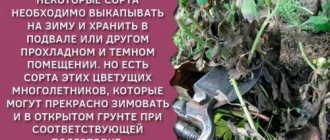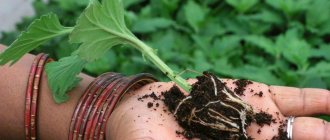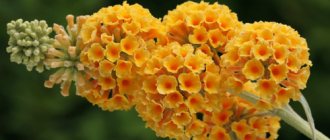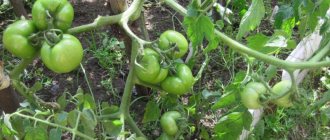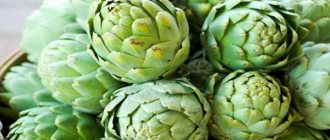In recent years, hosta has become very popular among Russian gardeners.
This is understandable. The flower grows well in the shade, which solves one of the main problems in decorating a site. Dear readers!
For you, we have created communities on social networks in which useful articles and interesting ideas are published several times a day! Subscribe and receive useful content in a convenient format! Hosta is a perennial herbaceous shrub. This means that every autumn it is necessary to carry out a set of measures to prepare this flower crop for winter.
Let's take a closer look at what care is needed.
What does autumn hosta care include?
Caring for hosta in the fall consists of standard agrotechnical measures.
- Removing shoots and leaves.
- Watering and fertilizing with nutritional compounds.
- Treatment with fungicidal and insecticidal agents.
- Weeding and mulching the area.
- Shelter for the winter to protect the roots from freezing.
REFERENCE. All of the above events are not held at once, but extend throughout the fall. Your goal in preparing for winter is to gradually slow down the growing season of the hosta so that it quietly goes into hibernation for the winter.
Preparing hostas for winter
Below are detailed step-by-step instructions that will help you qualitatively prepare hostas grown on your site for wintering.
- Preparation of mulching material
In this case, even ordinary garden soil will do. But many gardeners use a mixture of peat and mowed grass as a mulching material. You can also mulch your hosta with compost. These types of mulch will be a wonderful fertilizer for the crop in the spring.
- Mulching the hosta root zone
The prepared mulch is laid out in the root circle of the hosta so that its layer is 10...20 cm. The hosta itself cannot be covered with mulch if there are leaves on it. Those gardeners who trim the leaves of a bush in the fall can pour a mound of mulch directly onto it.
- Additional frost protection
If the winter is harsh and there is little snow, the hosts are covered with insulation, such as spruce branches, on top of the mulch. Spunbond, burlap, lutrasil and other types of breathable non-woven materials are often used from available means. You can secure the material by placing weights (bricks, boards, pipes or even bottles filled with water) around its perimeter.
- Removing winter shelter
In the spring, when the snow melts, it is necessary to immediately remove the shelter and mulch. When the temperature rises, the wrapped hostas may become warm. The old mulch is raked away to accelerate the warming of the soil and the start of crop growth.
If you properly and promptly prepare the hosts for wintering and, if necessary, cover them, they will survive the winter without loss and will quickly sprout in the spring. Despite the fact that this crop is considered quite cold-resistant, some of its exotic varieties, as well as ordinary ones growing in black areas of the country, can freeze out without high-quality insulation.
Caring for lilies in autumn, preparing for winter
Hosts. Preparing for winter: video
Features of autumn feeding host
Like other perennials, hosta is fed with potassium and phosphorus before winter.
The simplest feeding is 30 grams of potassium sulfate and superphosphate per square meter.
You can replace mineral fertilizers with wood ash or bone meal.
But it is not recommended to use humus, rotted manure and compost, as these fertilizers will provoke the growth of flower shoots.
It is also prohibited to use urea, ammonium nitrate, chicken manure and other fertilizers containing large amounts of nitrogen.
Treating hostas before wintering
This crop rarely becomes a victim of both insect pests and various fungal diseases.
However, as part of the general preparation of the garden for winter, this crop also needs to be sprayed with fungicides.
Use HOM. This is a modern remedy that is effective against most diseases. The treatment is carried out before pruning. And don’t forget to disinfect the soil under the perennial.
Pruning hosta in the fall
An important feature of pruning hostas in the fall in preparation for winter is the removal of faded buds. The fact is that this crop blooms for a very long time - from July to October.
Therefore, with the onset of autumn, experienced flower growers advise immediately removing unnecessary flower stalks. At the same time, if your hosta does not have very decorative flowering, then you can remove the flower stalks immediately, preventing them from releasing buds.
Next, you will need to decide whether to trim the leaves.
Hosta is a hardy perennial. It is able to survive the winter without any special preparation (including pruning). But there is a nuance here. Last year's tops will fall off in the spring in any case, giving space to new shoots.
So is it worth storing it in the fall? She can be hit by frost. Pathogenic microorganisms and pests can overwinter in it.
Therefore, it is still better to prune the hosta. This should be done when the shoots turn completely yellow. In this case, the growing season is completed.
The pruning itself will not cause any difficulties even for a novice gardener. We take a sharp pruner and cut the shoots 5-10 cm from the ground. We carefully collect the leaves and burn them.
IMPORTANT! Do not leave cut shoots to rot at the roots of the hosta. They can be favored by parasites.
You can also prune in the spring.
How to care for hostas in the fall
Preparing hostas for winter in the garden is not very difficult. These are winter-hardy and unpretentious plants that do not require careful shelter or repeated feeding. It is enough to moisten the soil, give autumn fertilizers (potassium, phosphorus), and also mulch the bushes. Before frost, it is recommended to carry out preventive treatment against diseases. As for pruning, you can remove dried flower stalks in mid-October.
Watering, fertilizing and mulching
Before winter, you should do the same with hostas as with ordinary plants: water, feed and mulch. Watering continues in the first half of autumn and until the end of October. Water is given as usual, taking into account rainfall: the plants are moisture-loving, but they should not be flooded either. Gradually (from the end of September) the volumes are reduced. The last moisture-recharging irrigation for the winter is carried out already in mid-October, on the eve of the onset of frost. There is no need to give more water.
It is also necessary to prepare the hosta for wintering in terms of feeding. To do this, at the end of September they give 2 fertilizers:
- potassium sulfate (20–30 g per 1 m2);
- superphosphate (30–40 g per 1 m2).
Instead, you can use bone meal (15–20 g) and wood ash (100 g). It is also recommended to use special complex fertilizers.
Important! Autumn preparation for winter of any plants does not include fertilizing with nitrogen.
If a complex fertilizer contains this element, it should absolutely not be given.
Preparing the plant for the winter period begins in October.
The hosta does not need to be covered with spruce branches, spunbond or other materials for the winter. But in most regions (except the south) it is necessary to mulch the soil thoroughly. To do this, use any natural material:
- bark;
- compost;
- mown grass;
- peat;
- sawdust;
- hay;
- straw.
You can use fertile soil (surface layer) as mulch. It will protect the roots of the plant from frost in winter, and also enrich the soil with nutrients. The mulch is placed on the ground in a layer of 5–10 cm. It is not necessary to cover the leaves of the plant - they will wither, and the shoots will normally survive frosts. Mulching can be done at the end of October.
Treatment against diseases and pests
Autumn care for hosta involves preparing for winter and the next season. Many pests hide from frost directly in the leaves, stems of plants and in the soil. With the onset of the warm season, insect larvae appear from eggs, and microscopic fungi emerge from spores, which leads to various diseases: gray rot, rust, hosta virus (a specific pest).
Read more Garden decoration by hosts: photos of flowers in a flowerbed, the best neighbors
Therefore, in the fall or early spring, it is recommended to carry out preventive treatment with fungicides (one drug to choose from):
- Bordeaux mixture;
- copper sulfate;
- "Fitosporin";
- "Tattu";
- "Profit";
- "Quadris";
- "Skor."
You can also use folk remedies:
- infusion of wood ash, crushed garlic cloves or onion peels;
- a weak solution of potassium permanganate (pale pink) or serum (diluted 10 times with water).
Attention! Caring for hostas in the fall and preparing for winter involves removing fallen leaves.
Some gardeners use litter as mulch. But it’s better not to do this, since pests can also overwinter in the leaves. If they are already affected by the disease, the bush is dug up and burned.
Pruning hosta in the fall
There are different opinions regarding the need to prune hostas. On the one hand, an annual haircut is absolutely necessary, but on the other hand, it can be done in the spring. Most hosta species and varieties are winter-hardy, so they overwinter well with leaves.
Pruning can be done after the leaves have turned yellow.
To understand whether a haircut is needed, it is recommended to pay attention to the appearance of the plant:
- If the hosta has many peduncles, they are partially removed. Do not touch the stems with leaves, otherwise the bush will not recover well after the autumn preparation for winter and will not be able to grow normally in the spring.
- If there are few flower stalks, they are removed completely. The remaining shoots are left. The main haircut is postponed until spring (sanitary, shaping, rejuvenating).
The procedure can be planned after the leaves begin to turn yellow. It is necessary to make it before the first frost. Autumn pruning to prepare for frosts is done in mid-October.
Do I need to cover the hosta for the winter?
Since hosta is a winter-hardy plant, it does not need to be covered for the winter. But in regions with a harsh climate (Ural, Siberia), you will need to mulch the bush.
How to cover a hosta for the winter
Experienced summer residents write that in some cases it is necessary to close the hosta for the winter. If there is little snow in the forecast, then in all regions (except the southern ones) it is recommended to cover the bushes with dry fallen leaves. To prevent the wind from blowing away the litter, spruce branches are placed on top. In early spring, the protective layer is removed, otherwise the plants may rot. This is exactly how autumn preparation is done.
Read more Diseases, hosta pests and their control
There are hosta varieties that can die after wintering outside after a few seasons. For example, summer residents write in their reviews that they did special autumn preparation; as a result, the bushes lived well for 4 winters in a row, and died on the fifth. In such cases, it is better not to take risks and take care not only of mulch, but also of a covering layer of foliage and spruce branches.
Do I need to dig up hostas for the winter?
Hosta wintering always takes place in open ground. Plants do not need to be dug up or moved home, to a cellar or greenhouse. Even moderately winter-hardy varieties survive the winter well. But so that they do not suffer from unexpected frosts and the lack of sufficient snow, they prepare the bushes for winter in the fall. They are covered with leaves and spruce branches.
There is no need to dig up hostas for the winter.
How to remove and preserve hosta in winter
After autumn preparation, in December, it is recommended to take care of the seedlings again. If there is not a lot of snow, you need to throw it on top of the foliage and spruce branches in a fairly large layer (the snowdrift should be loose). In March it is removed along with other covering materials. Thus, there is no need to store hosta at home in winter. It will overwinter well in open ground.
How to cover a hosta for the winter in different regions
In general, the hosta does not need to be covered for the winter. It is quite resistant to low temperatures.
For example, in the central zone, the Moscow region and the south of Russia, the crop winters well even without additional shelter.
But in the Leningrad region and, especially, in the Urals and Siberia, the host should be provided with minimal shelter. Mulching with sawdust or sprinkling with leaves will be sufficient.
But there is one caveat. If you grow hostas in your local area and are able to monitor the condition of the flowers all winter, then you definitely do not need to cover the hosta. If the flower grows in your dacha, where you will not appear until spring and will not be able to provide care in winter, then it is still worth covering the perennial. And here's the thing.
Snow is a natural shelter for plants. But in the case of a winter with little snow and frost, even the hosta can freeze. Therefore, it is worth sprinkling it with at least leaves. As soon as spring comes and it gets a little warmer, you simply remove this shelter.
Main events
Although the bush is perennial and survives even in cold and not too snowy winters, damage is inevitable if at least minimal treatment is not carried out. Whether to prune the entire hosta or not is a controversial issue for most gardeners, however, this is far from the only mandatory action that needs to be planned.
Trimming
Pruning refers to either removing flower stalks or cutting off all leaves. The first must be done at the end of summer. The plant is an ornamental deciduous plant, it does not produce beautiful lush buds, its flowering is extremely practical, aimed at scattering seeds. To achieve lush foliage, remove flowers immediately after the first yellow patches appear or a few days after they appear. If they still remain until autumn, they must be cut off before winter.
Gardeners who advocate pruning refer to the fact that this way the plant has time to accumulate more juices in the roots, due to which they become hardier and survive wintering easier. In the spring, the bush is no longer burdened with old leaves, does not waste time shedding them, but immediately begins to grow new ones. In addition, last year's growth can cause infection with various infections and can attract pests, which will negatively affect young greenery and ruin the appearance of the hosta.
Opponents of pruning, in turn, remind that leaves under a layer of snow will turn into compost. They will be a good mulch for the soil and will add the first nutrients that the plant needs so much in the spring. Importantly, untimely pruning of any hosta can be very dangerous. It is important that all cuts have time to close before the onset of the first cold weather. If you do not carry out this procedure at all, the risk of freezing is minimal.
Professional breeders believe that preparing the hosta for the upcoming winter and shelter can be limited to partial pruning. This is the safest option, although full processing is acceptable. This means that you can only remove limp and yellow leaves, peduncles and stems with suspected diseases, leaving the rest. This procedure cannot be completely abandoned; it can lead to the death of the bush.
Shelter
Hosta of any variety must be covered in the fall if temperatures drop below minus 10 degrees. This procedure is aimed at forming an increased snow cover; insulation itself is not required. You can refuse shelter in the southern regions.
It is important to choose the right material. The bush remains “alive” even under the snow, so roofing felt and plastic film will not work: moisture will accumulate under them, the air flow will be blocked, and the bush will rot. You can use:
First, carefully mulch the soil, then cover the bush completely, leaving a small “skirt” on the ground. Some gardeners increase the layers of cover in the area where the root system is located under the soil. If the bush is spreading, additional materials are pressed with thick branches, and the “crown” is pulled together with a rope or twine. This is reliable protection from the wind.
In the northern regions, a multi-layer shelter is required. The hosta is prepared for the long winter cold by covering the roots with a layer of peat, covering them with spruce branches, and protecting them on top with a geotextile with large pores. After the first snowfall in any region, you need to fill the bush yourself. This way, even with little rainfall, the hosta will be protected.
Preparation time
Planting and caring for hosta in open ground is the main method for most regions. Regardless of the region, preparation times are calculated the same way. After pruning, fertilizing and the last watering, 2-3 weeks should pass before the first frost. If it is not possible to complete all the work, it is better to refuse to remove the leaves and limit yourself only to trimming the peduncles.
In the Moscow region and central Russia there is no need for extensive cover of bushes. You can limit yourself to careful mulching and pruning. This work can be carried out from mid-September to mid-October. In the Volga region, special attention should be paid to protection from the wind, since large bushes may not withstand such a load.
In the climate of the Urals, it is necessary to take into account forecasts for each specific year. As a rule, snow cover appears here immediately; the first frosts begin at the end of October. Therefore, hosta preparation must begin in mid-September and be completed no later than the first days of October. Particular attention should be paid to mulching; the cover can be single-layer. If the forecast is for a winter with little snow, it is better to make several layers of protection and cover with additional snow.
Contrary to popular belief, hostas thrive in Siberian winter conditions. A thick layer of snow becomes their best protection. In areas closer to the Far East, precipitation is less and cold winds are stronger, which should be taken into account when preparing. The optimal shelter option is spruce branches, which are folded after thorough mulching. If severe frosts are expected, the bush can be additionally covered with soil mixed with straw. In areas with severe wind loads, it is necessary to additionally use agrofibre. Preparations must be completed by mid-September so that the first frosts do not damage the root system.
Milder winters occur in the Leningrad region, however, here the snow often does not linger and periodically melts until January. Therefore, it is important to carefully mulch the roots, cover and tie up the bush, especially if it is quite large and mature. All work is carried out until mid-October; it is permissible to cover the hosta in early November, however, pruning must be completed by the 15th of October.
Wintering of hosts in different regions
As mentioned above, hostas in different regions require slightly different care in the fall.
Let's consider the nuances of wintering a plant.
South
In the south of Russia, the hosta winters well without shelter. Moreover, the plant doesn’t even need to be pruned. The leaves will fall off on their own in the spring. Then you will remove them.
Middle zone and Moscow region
In Central Russia, it is advisable to mulch the flower by the third ten days of October. You can use sawdust, peat, fallen leaves.
Ural and Siberia
In these regions, the plant must be covered. Moreover, winter care includes adding snow as an additional natural covering material.
Volga region
In the Volga region, it is better to cover the perennial for the winter, as there are often severe frosts here.
The procedure must be carried out in the last ten days of October.
Ways to hide hosta
The method of covering the plant depends on the growing region. The main insulating layer is mulch.
The work is carried out in the following sequence:
- Mulch is prepared from tree bark or compost; peat, grass clippings, and fallen leaves are also suitable.
- Each bush is sprinkled on all sides with a layer of 10 cm. If the leaves are cut, a small mound is also made above the hosta stumps.
- In regions with severe frosts, it is necessary to cover the mulch with spruce branches or any non-woven material - spunbond or agrofibre.
It is important not to forget to remove the mulch from the roots of the plants when spring arrives, otherwise they will rot.
Common mistakes
- Use of nitrogen-containing fertilizers. Hosta is a herbaceous plant, and nitrogen is its favorite treat. But in the fall the flower should be limited. At this time of year, fertilizing should contain potassium and phosphorus.
- Use of synthetic covering material. Under agrofibre or film, the perennial “does not breathe”, which can provoke damping off and subsequent rotting.
- Too much cover. This is a frost-resistant plant, so it does not require a very thick layer of mulch or spruce branches. 5-10 cm will be enough.
- Hosta is not watered in the fall. Unlike other perennials, this flower must be watered until the temperature drops in order to saturate the roots with moisture before winter.
- Too much pruning. You don't have to trim the bush at all. If you decide on this procedure, then leave the “stumps” about 10 cm high.
- No processing. Be sure to spray with fungicides and insecticides. This is an important part of preparing for winter.
Mulching and watering
Is mulching necessary? This procedure must be carried out in September. It should be remembered that hosta is a moisture-loving plant. And it needs watering in the fall more than ever. The roots of the plant should be thoroughly wet. To do this, the bushes are shed at a depth of 40-50 cm.
Important! At the first frost on the soil, it is necessary to stop watering.
What to use as mulch
Natural mulch will be the lower leaves that fall off in the fall. Additionally, you will need a layer of mulch, for which the following are suitable:
Each gardener must determine for himself which type of mulch is most convenient for him to use. Each of them has its own advantages and disadvantages.
Pine bark. Mulching with bark looks very decorative. The bark protects the root system well and retains moisture for a long time. But its cost is high, and if many varieties of hosta are grown in the garden, it will be very expensive. Using bark as mulch is difficult if hostas are planted under trees. Decomposed bark will make it difficult to remove fallen leaves in the fall, which must be done.
Chopped branches. A gardener who has a special shredder can afford such mulch. Every year, when pruning garden trees and shrubs, many branches remain. Running them through a shredder will produce a large amount of material that can be used to mulch hostas. After a few years, such natural material turns into natural coarse compost. The disadvantage is the same - it is inconvenient to remove leaves with such mulch.
Peat. The first video shows how to mulch hostas with peat in pots and in open ground.
Sawdust. Convenient material, it is easy to mulch the area around the hosta. Looks attractive. But you need to have your own small wood processing plant to use sawdust as mulch over a large area of the garden.
Important! Before laying out mulch, it must be treated with insecticides. This will help kill or neutralize any pests and bacteria that may be in the mulch. To prevent snails from infesting it, it is additionally sprinkled with tobacco.
How is mulch applied? Mulch is mixed with dry soil and poured near the base of the hosta bush.
"Living" mulch for hosta
Some gardeners plant ground covers between hosta bushes. The most commonly used plant is Spanish sedum. This plant lines the ground like a rug. The only thing is that you also need to take care of it, and this is additional work.
Timing for applying mulch
The timing of applying organic mulch depends on the region where the hosta is planted.
- In Siberia, regions of the Urals, and the Far East, mulching is carried out until October 1.
- In the southern regions you can wait until the end of October.
- In the Moscow region, work is completed by mid-October.
Answers to frequently asked questions
What layer of mulch or leaves should I add if I cover the hosta for the winter?
The layer on top of the rhizome should be about 5-10 cm. Do not sprinkle mulch on top of the leaves. Here you will have to choose: either cut off the shoots for the winter and mulch, or leave the leaves, but then do without shelter.
Do we need to weed and loosen the soil?
Weeding and loosening are carried out before fertilizing. This way you remove the hostas' potential competitors for nutrients.
When to cover for the winter?
In the last ten days of October, after the first light frosts.

